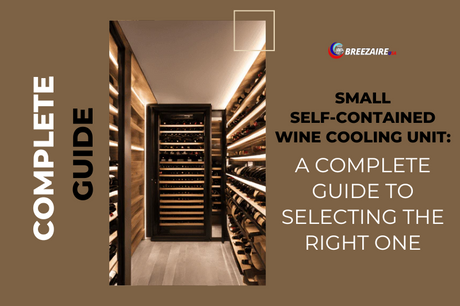Think Installing a Wine Cooling Unit Is Hard? Think Again.
By Jim Hopper, Wine Cooling Expert
Installing a wine cooling unit sounds intimidating—but it doesn’t have to be. With the Breezaire WKL Series, most homeowners can install a powerful, USA-made cooling unit in just a few hours.
This step-by-step guide will walk you through:
- What you need before starting
- Each installation step in order
- Common pitfalls to avoid
- How to test and maintain your unit post-install
Whether you're building a wine room from scratch or upgrading an old system, let’s make your cellar cool, efficient, and worry-free.
Related: Wine Cellar Installation Guide: How to Design & Cool with Breezaire USA →
1. What Is a Breezaire Self-Contained Unit (WKL Series)?
The WKL Series is Breezaire’s most popular line of through-the-wall, self-contained cooling systems. These units combine the evaporator and condenser into a single package that mounts directly into your cellar wall and vents warm air into an adjacent room.
Key Benefits:
- Fast install—ideal for DIYers
- Digital Sentry III+ controller
- Models available for up to 2000 cu. ft.
- Quiet, vibration-free operation
- Built in the USA with customer support

2. What You’ll Need Before You Begin
Tools:
- Drill/driver
- Measuring tape
- Drywall saw
- Level
- Screwdriver
- Safety goggles and gloves
Materials:
- Breezaire WKL unit
- Framed wall opening (check manual for cut-out dimensions)
- R-13+ insulation
- Vapor barrier (6-mil poly)
- 115V dedicated outlet
- Foam gasket or weatherproof seal
- Mounting hardware (included)
Tip: The exhaust room must be the same size or larger than the cellar and well-ventilated.

3. Quick Steps to Install a Breezaire WKL Unit
Google Snippet-Friendly Checklist:
- Measure and cut your wall opening
- Prep your power source
- Slide unit into opening and center it
- Seal and secure the unit
- Power on and test temperature
Estimated Time: 1–2 hours
Skill Level: Intermediate DIY
4. Step-by-Step Installation Guide
Step 1: Measure & Cut the Wall Opening
- Use the dimensions in your WKL model’s installation manual
- Frame with treated lumber and insulate cavity
- Apply vapor barrier on warm side of the wall
Step 2: Prepare Electrical
- Confirm nearby 115V outlet on its own 15-amp circuit
- Use a surge protector; never use an extension cord
Step 3: Slide, Center, and Seal
- Slide the unit from the warm side
- Center it using a level
- Apply foam seal around the unit to block airflow gaps
Step 4: Secure and Level
- Use provided screws to attach flanges to framing
- Ensure unit is completely level to allow proper drainage
Step 5: Power On and Set Temperature
- Plug in unit and activate digital controller
- Set temperature to 55°F
- Let run for 24 hours while monitoring temp and airflow

5. Common Mistakes to Avoid
- Installing into uninsulated wall cavities
- Venting into a small or unconditioned room
- Skipping the vapor barrier
- Using shared circuits or surge-stripped extension cords
- Not sealing all wall gaps or failing to level the unit

6. How to Test and Maintain Your Unit
Testing:
- Check temperature after 24 hours: 54–58°F
- Ensure consistent airflow and humidity (~50–70%)
- Use a thermometer and hygrometer to monitor stability
Maintenance:
- Clean condenser coil every 3–6 months
- Keep exhaust room cool and clear
- Check mounting hardware and seals annually
- Watch for blinking error codes or humidity spikes
Ready to Choose the Right WKL Unit?
The Breezaire WKL Series is one of the easiest ways to protect your wine collection at home. With proper insulation and a careful install, you’ll enjoy quiet cooling for years.
View the Full Collection →
📞 Call Us: 1 (800) 702-1381
📧 Email: support@breezaireusa.com








